📋 Should Corporate Leaders Prioritize Sustainability Over Short-Term Profits?
🌐 Introduction to the Topic
Opening Context: In a world grappling with climate change, resource scarcity, and social inequities, corporate leaders face a critical question—should they focus on long-term sustainability or short-term profits?
Topic Background: The debate stems from increasing environmental and societal pressures, fueled by global initiatives like the UN’s Sustainable Development Goals (SDGs). The balance between sustainability and immediate financial gains has become central for businesses, as stakeholders demand both profitability and responsible practices.
📊 Quick Facts and Key Statistics
- 🌍 Global ESG Investment: $37.8 trillion in 2023—projected to reach $50 trillion by 2025 (Bloomberg).
- 🔥 Climate Impact: Climate disasters cost the global economy $313 billion in 2022 (Swiss Re).
- 🛍️ Consumer Preference: 88% of consumers prefer sustainable brands (Nielsen).
- 📉 Financial Risk: Companies with poor ESG practices lose $1.2 trillion annually in market value (Morningstar).
👥 Stakeholders and Their Roles
- 🏢 Corporate Leaders: Responsible for decision-making, balancing profit goals with sustainable strategies.
- 📈 Investors: Increasing focus on ESG-aligned investments for risk mitigation and long-term growth.
- 🛍️ Consumers: Demanding sustainable and ethical business practices.
- 🏛️ Governments: Enforcing regulations and sustainability frameworks to promote corporate accountability.
- 🌍 NGOs and Activists: Driving awareness and pushing businesses toward sustainability goals.
🏆 Achievements and Challenges
🌟 Achievements
- 📊 Increased ESG Adoption: Companies like Unilever and Tesla have shown that sustainability can drive profitability.
- 💡 Reduced Costs: Energy-efficient operations reduce long-term costs (e.g., Apple’s carbon-neutral supply chain).
- 📜 Regulatory Success: EU’s Carbon Border Tax encourages global compliance on sustainability.
- 😊 Reputation Growth: Sustainable brands enjoy higher customer loyalty and premium pricing.
⚠️ Challenges
- 📉 Short-Term Pressure: Investors often demand immediate returns, hindering long-term sustainability goals.
- 💰 High Costs: Sustainable transitions require significant upfront investments.
- 🌍 Global Comparisons: Countries like Sweden excel in balancing sustainability with growth, but others lag behind.
- 📖 Case Study: BP’s shift toward renewables faced challenges in maintaining profits amidst energy market volatility.
🗣️ Structured Arguments for Discussion
- ✅ Supporting Stance: “Sustainability drives long-term profitability by reducing costs, enhancing brand loyalty, and ensuring resilience against regulatory risks.”
- ❌ Opposing Stance: “Short-term profitability is essential for survival, especially for small businesses or in economic downturns.”
- ⚖️ Balanced Perspective: “A phased approach to sustainability ensures profitability today while building long-term value for stakeholders.”
💡 Effective Discussion Approaches
📌 Opening Approaches
- 📊 Statistical Start: “With ESG investments set to hit $50 trillion by 2025, sustainability is no longer optional—it’s essential for business survival.”
- 🔄 Contrast Approach: “While short-term profits ensure survival, companies ignoring sustainability face long-term risks, including regulatory penalties.”
↔️ Counter-Argument Handling
- 📊 Example: “While upfront costs of sustainability are high, studies show companies that adopt ESG practices outperform peers in the long run.”
- 📈 Data Example: “Unilever reported a 20% increase in sustainable brand sales, showcasing long-term benefits over short-term profits.”
📋 Strategic Analysis of Strengths and Weaknesses
📊 SWOT Analysis
- 💪 Strengths: Enhanced reputation, regulatory compliance, operational efficiency.
- ⚠️ Weaknesses: Short-term financial strain, lack of expertise, upfront investments.
- 🌟 Opportunities: Access to green financing, competitive edge, global partnerships.
- 🚧 Threats: Market pressure, economic uncertainty, greenwashing accusations.
🎓 Connecting with B-School Applications
- 📂 Real-World Applications: Sustainability-focused case studies (e.g., Tesla, Patagonia) in corporate projects.
- 📘 Finance: Green bonds, ESG funds, and sustainable investing strategies.
- 💡 Sample Interview Questions:
- ❓ “How can sustainability become a competitive advantage for businesses?”
- ❓ “What challenges do companies face while balancing short-term profitability and long-term sustainability?”
- 📖 Insights for B-School Students: Sustainability practices align with corporate strategy, innovation, and finance projects. ESG knowledge is increasingly essential for roles in consulting, finance, and operations.


